

General Artificial Intelligence and the Global Brain. Ben Goertzel: General Artificial Intelligence and the Global Brain. OpenCog. OpenCog is a unique and ambitious open-source software project.
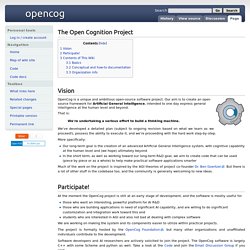
Our aim is to create an open source framework for Artificial General Intelligence, intended to one day express general intelligence at the human level and beyond. That is: We're undertaking a serious effort to build a thinking machine. We've developed a detailed plan (subject to ongoing revision based on what we learn as we proceed!) , possess the ability to execute it, and we're proceeding with the hard work step-by-step. More specifically: Our long-term goal is the creation of an advanced Artificial General Intelligence system, with cognitive capability at the human level and (we hope) ultimately beyond In the short term, as well as working toward our long-term R&D goal, we aim to create code that can be used (piece by piece or as a whole) to help make practical software applications smarter.
OpenCog. OpenCog is a project that aims to build an open source artificial intelligence framework.
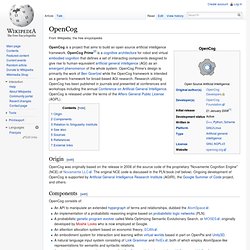
OpenCog Prime[2] is a cognitive architecture for robot and virtual embodied cognition that defines a set of interacting components designed to give rise to human-equivalent artificial general intelligence (AGI) as an emergent phenomenon of the whole system. OpenCog Prime's design is primarily the work of Ben Goertzel while the OpenCog framework is intended as a generic framework for broad-based AGI research. Research utilizing OpenCog has been published in journals and presented at conferences and workshops including the annual Conference on Artificial General Intelligence. AGI 2011: OpenCog. OpenCog. Last updated: Sep 28, 2012 OpenCog is an open-source software project to build a human-level artificial general intelligence (AGI).

The name "OpenCog" is derived from "open", meaning open source, and "cog", meaning cognition. OpenCog doesn't emulate the human brain in any detail. Instead it uses currently available computer hardware to run software that draws inspiration from neuroscience, cognitive psychology, and computer science. The Future of Artificial Intelligence According to Ben Goertzel. Since the inception of the discipline of artificial intelligence (AI) in the 1950s, progress in the field has advanced at a rapid pace.
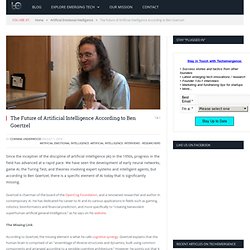
We have seen the development of early neural networks, game AI, the Turing Test, and theories involving expert systems and intelligent agents, but according to Ben Goertzel, there is a specific element of AI today that is significantly missing. Goertzel is chairman of the board of the OpenCog Foundation, and a renowned researcher and author in contemporary AI. He has dedicated his career to AI and its various applications in fields such as gaming, robotics, bioinformatics and financial prediction, and more specifically to “creating benevolent superhuman artificial general intelligence,” as he says on his website. The Missing Link According to Goertzel, the missing element is what he calls cognitive synergy. Ben Goertzel on Open Cog - Building Better Minds Together. Monash Talk - Ben Goertzel - Open Cog 2011-08-23. Ben Goertzel in HK - About Open Cog. Artificial Intelligence and Mind Uploads In Space According To Ben Goertzel.
The Future of Artificial Intelligence. The word “robot” was used for the first time only about 80 years ago, in the play “RUR” by the Czech author Karel Capek.
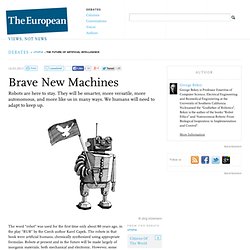
The robots in that book were artificial humans, chemically synthesized using appropriate formulas. Robots at present and in the future will be made largely of inorganic materials, both mechanical and electronic. However, some form of hybridization between electromechanical and biological subsystems is possible and will occur. I believe that the major developments in robotics in the next 100 years will be the following areas: Robot intelligence. . - High speed memory, long term storage capacity, and speed of the on-board computers will continue to increase.
. - Neuroscience is rapidly obtaining better and better models of the information processing ability of the human brain. . - Research in learning will enable robots to learn by imitating humans, from their own mistakes and from their successes. Human-robot interaction. Humanity’s robotic future Functions in society. Building Better Minds.
Building Better Minds, by Dr.
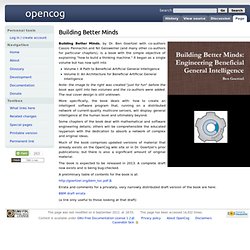
Ben Goertzel at TEDxHongKong. A Mind-World Correspondence Principle. Open Cog. General Intelligence via Cognitive Synergy OpenCog is a diverse assemblage of cognitive algorithms, each embodying their own innovations — but what makes the overall architecture powerful is its careful adherence to the principle of cognitive synergy.
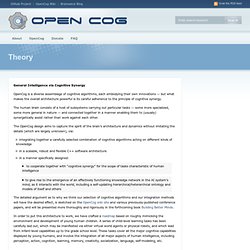
The human brain consists of a host of subsystems carrying out particular tasks — some more specialized, some more general in nature — and connected together in a manner enabling them to (usually) synergetically assist rather than work against each other. Agent. A MindAgent is a software module that performs computations.
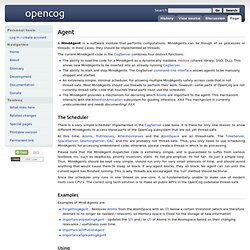
MindAgents can be though of as processes or threads; in most cases, they should be implemented as threads. The current MindAgent code in the CogServer combines four distinct functions: The ability to load the code for a MindAgent as a dynamically loadable module (shared library, DSO, DLL). This allows new MindAgents to be inserted into an already-running CogServer. Atom. This page describes the Atom class.
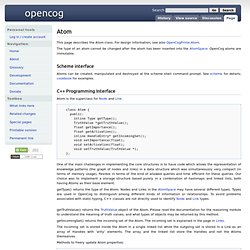
For design information, see also OpenCogPrime:Atom. The type of an atom cannot be changed after the atom has been inserted into the AtomSpace: OpenCog atoms are immutable. Scheme interface Atoms can be created, manipulated and destroyed at the scheme shell command prompt. See scheme for details; cookbook for examples. MindOntology:Novamente Cognition Engine. Developed by Novamente, the Novamente Cognition Engine (NCE) is a software system designed for large-scale implementation on a distributed network, and founded on a unique AGI design grounded in a systems theory of intelligence.
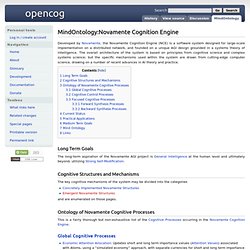
The overall architecture of the system is based on principles from cognitive science and complex systems science; but the specific mechanisms used within the system are drawn from cutting-edge computer science, drawing on a number of recent advances in AI theory and practice. Long Term Goals. Core. Glossary. Foundation. This FAQ is very incomplete at present. If you have more questions you’d like to see addressed please email one the mailing lists and the answers may wind up here. Attention allocation. Attention allocation within OpenCog weights pieces of knowledge relative to one another, based on what has been important to the system in the past and what is currently important. Attention allocation has several purposes: To guide the process of working out what knowledge should be stored in memory, what should be stored locally on disk, and what can be stored distributed on other machines.
To guide the forgetting process. Deleting knowledge that is deemed to not be use any more (or that has been integrated into system in other ways, e.g. raw perceptual data). Ben Goertzel. Building better minds together. BAI2013 keynote talk: Ben Goertzel - "Beyond Artificiality, Generality and Intelligence"